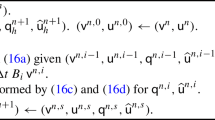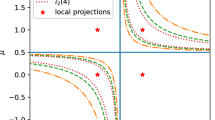Abstract
We construct three efficient and accurate numerical methods for solving the Klein–Gordon–Schrödinger (KGS) equations with/without damping terms. The first one is based on the original SAV approach, it preserves a modified Hamiltonian but does not preserve the wave energy. The second one is based on the Lagrange multiplier SAV approach, it preserves both the original Hamiltonian and wave energy, but requires solving a nonlinear algebraic system which may require smaller time steps to have real solutions. The third one is also based on the Lagrange multiplier approach and preserves the Hamiltonian and wave energy in a slightly different form, but it leads to a nonlinear quadratic system for the Lagrange multiplier which can always be explicitly solved. We present ample numerical tests to validate the three schemes, and provide a comparison on the efficiency and accuracy of the three schemes for the KGS equations.









Similar content being viewed by others
Data Availibility Statement
Data sharing not applicable to this article as no datasets were generated or analyzed during the current study.
References
Antoine, X., Shen, J., Tang, Q.: Scalar Auxiliary Variable/Lagrange multiplier based pseudospectral schemes for the dynamics of nonlinear Schrödinger/Gross–Pitaevskii equations. J. Comput. Phys. 437, 110328 (2021)
Bao, W., Chunmei, S.: Uniform error estimates of a finite difference method for the Klein–Gordon–Schrödinger system in the nonrelativistic and massless limit regimes. Kinetic Related Models 11(4), 1037–1062 (2018)
Bao, W., Yang, L.: Efficient and accurate numerical methods for the Klein–Gordon–Schrödinger equations. J. Comput. Phys. 225(2), 1863–1893 (2007)
Bao, W., Zhao, X.: A uniformly accurate (UA) multiscale time integrator Fourier pseudospectral method for the Klein–Gordon–Schrödinger equations in the nonrelativistic limit regime. Numer. Math. 135(3), 833–873 (2017)
Biler, P.: Attractors for the system of Schrödinger and Klein–Gordon equations with Yukawa coupling. SIAM J. Math. Anal. 21(5), 1190–1212 (1990)
Boling, G., Yongsheng, L.: Attractor for dissipative Klein–Gordon–Schrödinger equations in R3. J. Differ. Equ. 136(2), 356–377 (1997)
Castillo, P., Gómez, S.: Conservative local discontinuous Galerkin method for the fractional Klein–Gordon–Schrödinger system with generalized Yukawa interaction. Numer. Algorithms 84(1), 407–425 (2020)
Chen, J., Chen, F.: Convergence of a high-order compact finite difference scheme for the Klein–Gordon–Schrödinger equations. Appl. Numer. Math. 143, 133–145 (2019)
Cheng, Q., Liu, C., Shen, J.: A new Lagrange multiplier approach for gradient flows. Comput. Methods Appl. Mech. Eng. 367, 113070 (2020)
Cheng, Q., Shen, J.: Global constraints preserving scalar auxiliary variable schemes for gradient flows. SIAM J. Sci. Comput. 42(4), A2489–A2513 (2020)
Feng, X., Li, B., Ma, S.: High-order mass-and energy-conserving SAV-Gauss collocation finite element methods for the nonlinear Schrödinger equation. SIAM J. Numer. Anal. 59(3), 1566–1591 (2021)
Fu, Y., Hu, D., Wang, Y.: High-order structure-preserving algorithms for the multi-dimensional fractional nonlinear Schrödinger equation based on the SAV approach. Math. Comput. Simul. 185, 238–255 (2021)
Fukuda, I., Tsutsumi, M.: On coupled Klein–Gordon–Schrödinger equations. I. Bulletin of Science and Engineering Research Laboratory. Waseda University, 69:51–62 (1975)
Fukuda, I., Tsutsumi, M.: On the Yukawa-coupled Klein–Gordon–Schrödinger equations in three space dimensions. Proc. Jpn. Acad. 51(6), 402–405 (1975)
Fukuda, I., Tsutsumi, M.: On coupled Klein–Gordon–Schrödinger equations II. J. Math. Anal. Appl. 66(2), 358–378 (1978)
Fukuda, I., Tsutsumi, M.: On coupled Klein–Gordon–Schrödinger equations. III. Higher order interaction, decay and blow-up. Math. Japonica, 24(3), 307–321 (1979/80)
Guo, B.: Global solution for some problem of a class of equations in interaction of complex Schrödinger field and real Klein–Gordon field. Sci. China Ser. A Math. 25, 97–107 (1982)
Guo, B., Miao, C.: Asymptotic behavior of coupled Klein–Gordon–Schrödinger equations. Sci. China Ser. A Math. 25(7), 705–714 (1995)
Hayashi, N., von Wahl, W.: On the global strong solutions of coupled Klein–Gordon–Schrödinger equations. J. Math. Soc. Jpn. 39(3), 489–497 (1987)
Hong, J., Jiang, S., Kong, L., Li, C.: Numerical comparison of five difference schemes for coupled Klein–Gordon–Schrödinger equations in quantum physics. J. Phys. A: Math. Theor. 40(30), 9125–9135 (2007)
Hong, J., Jiang, S., Li, C.: Explicit multi-symplectic methods for Klein–Gordon–Schrödinger equations. J. Comput. Phys. 228(9), 3517–3532 (2009)
Ji, B., Zhang, L.: A dissipative finite difference Fourier pseudo-spectral method for the Klein–Gordon–Schrödinger equations with damping mechanism. Appl. Math. Comput. 376(125148), 125148 (2020)
Kong, L., Chen, M., Yin, X.: A novel kind of efficient symplectic scheme for Klein–Gordon–Schrödinger equation. Appl. Numer. Math. 135, 481–496 (2019)
Kong, L., Zhang, J., Cao, Y., Duan, Y., Huang, H.: Semi-explicit symplectic partitioned Runge–Kutta Fourier pseudo-spectral scheme for Klein–Gordon–Schrödinger equations. Comput. Phys. Commun. 181(8), 1369–1377 (2010)
Li, M., Shi, D., Wang, J., Ming, W.: Unconditional superconvergence analysis of the conservative linearized Galerkin FEMs for nonlinear Klein–Gordon–Schrödinger equation. Appl. Numer. Math. 142, 47–63 (2019)
Liang, H.: Linearly implicit conservative schemes for long-term numerical simulation of Klein–Gordon–Schrödinger equations. Appl. Math. Comput. 238, 475–484 (2014)
Lu, K., Wang, B.: Global attractors for the Klein–Gordon–Schrödinger equation in unbounded domains. J. Differ. Equ. 170(2), 281–316 (2001)
Makhankov, V.G.: Dynamics of classical solitons (in non-integrable systems). Phys. Rep. 35(1), 1–128 (1978)
Poulain, A., Schratz, K.: Convergence, error analysis and longtime behavior of the Scalar Auxiliary Variable method for the nonlinear Schrödinger equation. arXiv preprint arXiv:2012.13943 (2020)
Ray, S.S.: An application of the modified decomposition method for the solution of the coupled Klein–Gordon–Schrödinger equation. Commun. Nonlinear Sci. Numer. Simul. 13(7), 1311–1317 (2008)
Shen, J., Jie, X., Yang, J.: The scalar auxiliary variable (SAV) approach for gradient flows. J. Comput. Phys. 353, 407–416 (2018)
Shen, J., Zheng, N.: Efficient and accurate sav schemes for the generalized Zakharov systems. Discrete Contin Dyn Syst-B 26(1), 645 (2021)
Wang, B., Lange, H.: Attractors for the Klein–Gordon–Schrödinger equation. J. Math. Phys. 40(5), 2445–2457 (1999)
Wang, J., Liang, D., Wang, Y.: Analysis of a conservative high-order compact finite difference scheme for the Klein–Gordon–Schrödinger equation. J. Comput. Appl. Math. 358, 84–96 (2019)
Wang, J., Xiao, A.: An efficient conservative difference scheme for fractional Klein–Gordon–Schrödinger equations. Appl. Math. Comput. 320, 691–709 (2018)
Xiang, X.: Spectral method for solving the system of equations of Schrödinger–Klein–Gordon field. J. Comput. Appl. Math. 21, 161–171 (1988)
Yang, H.: Error estimates for a class of energy- and Hamiltonian-preserving local discontinuous Galerkin methods for the Klein–Gordon–Schrödinger equations. J. Appl. Math. Comput. 62(1–2), 377–424 (2020)
Zhang, L.: Convergence of a conservative difference scheme for a class of Klein–Gordon–Schrödinger equations in one space dimension. Appl. Math. Comput. 163(1), 343–355 (2005)
Acknowledgements
This work is supported in part by NSFC 11971407, NSF DMS-2012585 and AFOSR FA9550-20-1-0309.
Author information
Authors and Affiliations
Corresponding author
Ethics declarations
Conflict of interest
The authors declare that they have no conflict of interest.
Additional information
Publisher's Note
Springer Nature remains neutral with regard to jurisdictional claims in published maps and institutional affiliations.
Appendix A: \(F_1\) and \(F_2\) in (3.23)
Appendix A: \(F_1\) and \(F_2\) in (3.23)
The exact forms of nonlinear functions \(F_1\) and \(F_2\) in (3.23) are
and
Rights and permissions
About this article
Cite this article
Zhang, Y., Shen, J. Efficient Structure Preserving Schemes for the Klein–Gordon–Schrödinger Equations. J Sci Comput 89, 47 (2021). https://doi.org/10.1007/s10915-021-01649-y
Received:
Revised:
Accepted:
Published:
DOI: https://doi.org/10.1007/s10915-021-01649-y




